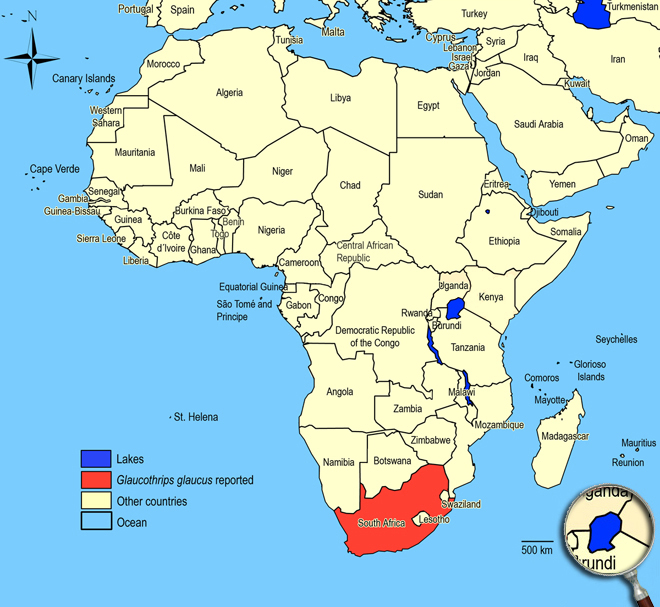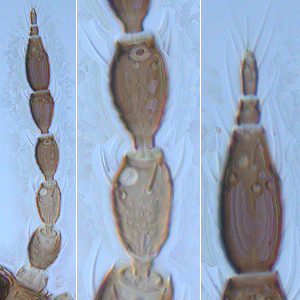Glaucothrips glaucus (Bagnall, 1914)
Thripinae, Thripidae, Terebrantia, Thysanoptera
Figures
Fig. 1: 8-segmented antenna, segments III and IV with forked sense cone, terminal segments VI-VIII
Fig. 2: Head dorsal with ocellar triangle
Fig. 3: Pronotum
Fig. 4: Meso- and metanotum
Fig. 5: Fore- and hind wing, fore wing distal region
Fig. 6: Tergites III-V
Fig. 7: Sternites VI and VII
Fig. 8: Tergite VIII with posteromarginal comb and tergite IX
Introduction and recognition
Glaucothrips glaucus breeds in flowers of Proteaceae like Queen Protea (Protea barbigera) and plum tree (Prunus sp.). Both sexes fully winged; body color brown; legs and antennal segments I & III pale; fore wings brown shaded. Antennae 8-segmented; segments III & IV with short forked sense cone (Fig. 1). Head wider than long; postocular region with about 8 transverse lines; 3 pairs of ocellar setae present, pair III on anterolateral margins of ocellar triangle and a little shorter than one side of triangle; 5 pairs of postocular setae, pair II from midline close to posterior ocelli (Fig. 2). Pronotum transversely striate; with 1 pair of elongate posteroangular setae and 4 pairs of posteromarginal setae (Fig. 3). Meso- and metafurca without spinula. Metanotum irregularly reticulate; median setae shorter than lateral sete and arise well behind anterior margin; campaniform sensilla present (Fig. 4). Mid and hind tarsi 2-segmented. Fore wing with 2 complete rows of veinal setae - first vein with 15-22 setae, second vein with 13-15 setae (Fig. 5). Tergites with transverse reticulations medially (Fig. 6); median setae on VI-VIII at least one third as long as the tergite; posterior margin of tergite VIII with a complete comb of long (Fig. 8), slender irregular or regular microtrichia with stout bases; tergite X with a complete longitudinal split. Sternites without discal setae but with 3 or 4 pairs of posteromarginal setae; sternite VII with median and submedian setae arising in front of posterior margin (Fig. 7).
Male similar to female but smaller; glandular area medially only on sternites III indicated.
Taxonomic identity
Species
Glaucothrips glaucus (Bagnall, 1914)
Taxonomic history
Pseudanaphothrips turneri Moulton, 1936
Pseudothrips glaucus Bagnall, 1914
Common name
-
Present taxonomic position
Family: Thripidae Stephens, 1829
Subfamily: Thripinae (Stephens) Karny, 1921
Genus: Glaucothrips Karny, 1921
Genus description
The genus Glaucothrips Karny, 1921
There are only 1 species in this genus, which is widespread in South Africa with following characters: 8-segmented antennae with short forked sense cone on segments III & IV, pronotum with 1 pair of elongate posteroangular setae and 4 pairs of posteromarginal setae, fore wing first and second vein with complete row of setae, and posterior margin of tergite VIII with a complete comb of long and regular microtrichia with stout bases.
Species description
Typical key character states of Glaucothrips glaucus
Coloration and body sculpture
Body color: mainly brown to dark brown
Surface of head, pronotum and fore legs: without obvious or with weakly reticulate sculpture
Antennae
Form of sense cones on antennal segments III and IV: emergent and forked on segments III and IV
Number of antennal segments: 8
Antennal segment I: without any setae on dorsal apical margin
Antennal segment II: without an exceptionally long seta at the inner apex
Antennal segment II shape: symmetric
Antennal segment III shape: symmetric
Length of antennal segment III and IV: antennal segment III similar in length to segment IV
Forked sense cone on antennal segment IV: scarcely extending beyond base of segment V
Antennal segment IV and V: without a hyaline ring near the base
Antennal segment VI bears: not a remarkably dagger-shaped sensorium
Head
Distance between bases of ocellar setae III: greater than width of first ocellus
Head: not prolonged in front of compound eyes
Ocellar setae I: present
Ocellar setae III: arising on anterior margin of, or in front of ocellar triangle
Ocelli: present
Length of postocular setae: not alternating short and long setae
Number of ocellar setae: 3
Prothorax
Number of pairs of long anteroangular setae: 0
Number of pairs of long posteroangular setae: 1
Number of pairs of elongate pronotal setae: 1
Number of pairs of posteromarginal minor setae: 4
Pronotal blotch or internal apodeme: absent
Pronotum shape: broadly rectangular
Pronotum posteromarginal/posteroangular setae: S2 longer than S3, not equal in length
Mesothorax
Mesosternal furca: without spinula
Metathorax
Metanotal campaniform sensilla: present
Metanotal median setae: S1 behind anterior margin
Metanotum with dominant sculptured triangle medially: absent
Metasternal furca: without spinula
Sculpture of metanotum median area: transverse at anterior, but irregular longitudinal or equiangular reticulations on posterior half or with mainly equiangular reticulation
Shape of metathoracic furca: transverse, V-shaped
Metanotal median setae length: shorter than lateral metanotal setae
Wings
Fore and hind wings: present, more than half as long as abdomen (macropterous)
Fringe cilia arising: from sockets
Fore wing veins: present
Fore- and hind wing surface: covered with microtrichia
Apex of fore wing: with prominent terminal setae
Fore wing anterior margin (costal vein): with setae and cilia but cilia longer than setae
Fore wing costal fringe cilia: arising at anterior margin of wing
Fore wing first vein: distinct from costal vein
Fore wing first vein setal row: complete, with setae closely and uniformly spaced
Fore wing second vein setal row: complete, setae uniformly spaced
Fore wing shape: mainly parallel sided or margins run continuously towards each other
Fore wing surface: not reticulate
Fringe cilia on posterior margin near apex: distinctly wavy (undulated)
Length of fore wing costal setae at middle of wing: longer than half of median wing width
Shape of fore wing apex: with mainly posterior margin curved to join anterior margin
Fore wing extreme apex color: dark (rare: pale)
Fore wings: uniformly light brown
Legs
Fore tibia: not prolonged around fore tarsus
Mid and hind tarsi: with two segments
Color of fore tarsi: brown or pale or yellow, sometimes apical shaded or brown
Abdomen
Pleurotergites: not covered in microtrichia
Sternite II: with marginal setae but no discal setae
Sternites IV, V and VI: with marginal setae but no discal setae
Sternite VII median posteromarginal setae S1: arising in front of posterior margin
Sternite VII: with marginal setae but no discal setae
Surface of lateral thirds of abdominal tergites: without regular rows of fine microtrichia
Craspedum on tergites IV to VI: absent
Tergites IV and V median setal pair: shorter than distance between their bases
Tergites V to VII: without ctenidia laterally, but sometimes with rows of microtrichia
Craspedum on tergite VIII: without craspedum medially and toothlike microtrichia laterally
Tergite VIII ctenidia: without paired ctenidia laterally, sometimes with irregular microtrichia
Tergite VIII posteromarginal comb of microtrichia: present and complete medially
Tergite VIII shape of posteromarginal microtrichia: long, slender and irregular or regular
Tergite X: not tubular, longitudinally incomplete
Setae on abdominal tergite X: all setae slender

Similar or related species
Glaucothrips glaucus is similar to species of the genus Frankliniella and Megalurothrips sjostedti in having the fore wing first and second vein complete rows of setae (in Megalurothrips sjostedti the fore wing first vein is almost complete but usually with a short subapical gap followed by 2 setae), and in having 8-segmented antennae with forked sense cone on segments III and IV. Compared to Glaucothrips glaucus, species of Frankliniella and Megalurothrips sjostedti have 2 pairs of elongate posteroangular setae, and metanotal median setae are longer than lateral setae and arising at anterior margin (Glaucothrips glaucus with only 1 pair of elongate posteroangular setae, and metanotal median setae shorter than lateral setae and arising behind anterior margin). Furthermore, species of Frankliniella with paired ctenidia laterally on tergites V-VIII (absent in Glaucothrips glaucus and Megalurothrips sjostedti), and in Megalurothrips sjostedti the posteromarginal comb of short microtrichia is broadly absent medially (complete in Glaucothrips glaucus). Other species of the subfamily Thripinae with complete setal rows on fore wing first and second vein (Bolacothrips striatopennatus, species of Synaptothrips, Thrips australis, Thrips orientalis, and Thrips parvispinus) have either 7 or 9 antennal segments.
Biology
Life history
As with other thrips species the life cycle from egg to adult is dependent on temperature. The full cycle can take less than one week to over a month and adults may live for more than one month producing several generations in one year depending on seasonal weather (Lewis 1973).
Host plants
Proteaceae like Queen Protea (Protea barbigera), plum tree (Prunus sp.).
Vector capacity
None identified, but possible mechanical distribution of phytopathogenic fungi and bacteria.
Damage and symptoms
-
Detection and control strategies
-
Additional notes
-
Biogeography
South Africa (Western Cape: Cape Town, Mossel Bay, Rawsonville, Stellenbosch, Betty's Bay).
African countries where Glaucothrips glaucus has been reported

The species Glaucothrips glaucus was not observed in surveys undertaken in East Africa on vegetables and associated weeds and crops.
Please click here for survey sites of all observed thrips species of Kenya, Tanzania and Uganda.

Bibliography
Bagnall RS (1914). Brief descriptions of new Thysanoptera - II. Annals and Magazine of Natural History, Zoology, Botany and Geology. (Serie 8) 13: 22-31
Karny H (1921). Zur Systematik der Orthopteroiden Insekten, Thysanoptera. Treubia. 1: 211-269
Lewis T (1973). Thrips: their biology, ecology and economic importance. Academic Press Inc., London Ltd., 349 pp
Moulton D (1936). Thysanoptera from Africa. Annals and Magazine of Natural History, Zoology, Botany and Geology. (Serie 10) 17: 493-509
Mound LA (1968). A review of R. S. Bagnalľs Thysanoptera collections. Bulletin of the British Museum (Natural History), Entomology. Supplement 11: 1-181
Nickle DA (2003). A checklist of commonly intercepted thrips (Thysanoptera) from Europe, the Mediterranean, and Africa at U.S. ports-of-entry (1983-1999). Part I. Key to genera. Proceedings of the Entomological Society of Washington. 105 (1): 80-99
zur Strassen R (1960). Catalogue of the known species of South African Thysanoptera. Journal of the Entomological Society of Southern Africa. 23 (2): 321-367
zur Strassen R (1968). New records of South African Thysanoptera with description of a new Phlaeothripid genus. Journal of the Entomological Society of Southern Africa. 31 (2): 365-372
----
Web links
Mound´s Thysanoptera pages
Thysanoptera Checklist
ICIPE Thrips survey sites
UNI Halle & Thrips sites
Thrips of California











